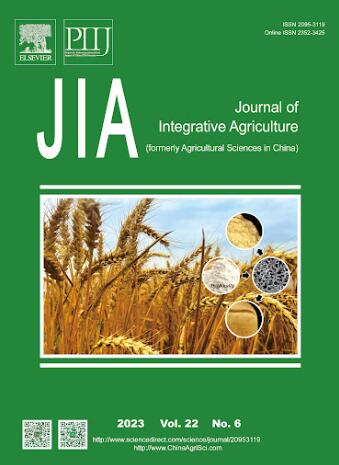2020 至 2022 年中国中部地区分离到的 H9N2 禽流感病毒的遗传和生物学特性
IF 4.4
1区 农林科学
Q1 AGRICULTURE, MULTIDISCIPLINARY
引用次数: 0
摘要
H9N2 亚型禽流感病毒(AIV)在全球家禽和野鸟中广泛流行,并已成为在中国家禽中流行的主要亚型。H9N2 亚型禽流感病毒可直接或间接(作为 "供体病毒")感染人类,对公众健康构成重大威胁。目前,中国中部山西省缺乏对 H9N2 病毒流行情况的深入研究。在这项研究中,我们从 2020 年 10 月至 2022 年 4 月在山西省分离到了 14 种 H9N2 AIV,基因分析表明这些病毒属于 7 种不同的基因型。对动物的研究表明,我们发现的 H9N2 株系在鸡群中传播效率很高,并且在这些禽类中表现出不同的复制能力。这些病毒能在小鼠肺部有效复制,其中一种毒株还能在大脑和肾脏等器官中复制。在细胞水平上,使用斑块形成试验和多步生长曲线试验评估了不同 H9N2 株系的复制能力,结果显示各种 H9N2 病毒在细胞水平上的复制和增殖效率存在显著差异。抗原性分析表明,这些分离株可分为两个不同的抗原群。我们的研究为了解华中地区 H9N2 禽流感的流行情况和生物学特征提供了重要数据。研究还强调了加强 H9N2 禽流感监测的必要性。本文章由计算机程序翻译,如有差异,请以英文原文为准。
Genetic and biological properties of H9N2 avian influenza viruses isolated in central China from 2020 to 2022
The H9N2 subtype of avian influenza virus (AIV) is widely prevalent in poultry and wild birds globally, and has become the predominant subtype circulating in poultry in China. The H9N2 AIV can directly or indirectly (by serving as a “donor virus”) infect humans, posing a significant threat to public health. Currently, there is a lack of in-depth research on the prevalence of H9N2 viruses in Shanxi Province, central China. In this study, we isolated 14 H9N2 AIVs from October 2020 to April 2022 in Shanxi Province, and genetic analysis revealed that these viruses belonged to seven different genotypes. Our study on animals revealed that the H9N2 strains we identified displayed high transmission efficiency among chicken populations, and exhibited diverse replication abilities within these birds. These viruses could replicate efficiently in the lungs of mice, with one strain also demonstrating the capacity to reproduce in organs like the brain and kidneys. At the cellular level, the replication ability of different H9N2 strains was evaluated using plaque formation assays and multi-step growth curve assays, revealing significant differences in the replication and proliferation efficiency of the various H9N2 viruses at the cellular level. The antigenicity analysis suggested that these isolates could be classified into twoseparate antigenic clusters. Our research provides crucial data to help understand the prevalence and biological characteristics of H9N2 AIVs in central China. It also highlights the necessity of enhancing the surveillance of H9N2 AIVs.
求助全文
通过发布文献求助,成功后即可免费获取论文全文。
去求助
来源期刊

Journal of Integrative Agriculture
AGRICULTURE, MULTIDISCIPLINARY-
CiteScore
7.90
自引率
4.20%
发文量
4817
审稿时长
3-6 weeks
期刊介绍:
Journal of Integrative Agriculture publishes manuscripts in the categories of Commentary, Review, Research Article, Letter and Short Communication, focusing on the core subjects: Crop Genetics & Breeding, Germplasm Resources, Physiology, Biochemistry, Cultivation, Tillage, Plant Protection, Animal Science, Veterinary Science, Soil and Fertilization, Irrigation, Plant Nutrition, Agro-Environment & Ecology, Bio-material and Bio-energy, Food Science, Agricultural Economics and Management, Agricultural Information Science.
 求助内容:
求助内容: 应助结果提醒方式:
应助结果提醒方式:


